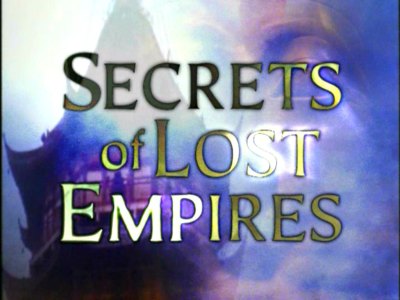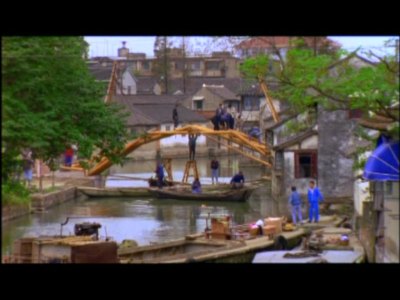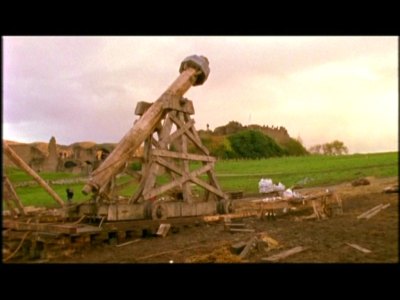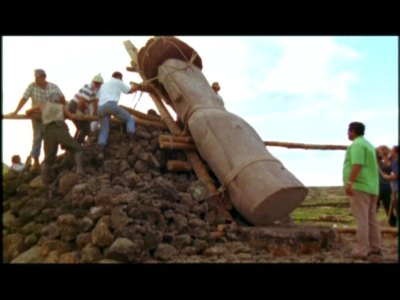| Reviews & Columns |
|
Reviews DVD TV on DVD Blu-ray 4K UHD International DVDs In Theaters Reviews by Studio Video Games Features Collector Series DVDs Easter Egg Database Interviews DVD Talk Radio Feature Articles Columns Anime Talk DVD Savant Horror DVDs The M.O.D. Squad Art House HD Talk Silent DVD
|
DVD Talk Forum |
|
|
| Resources |
|
DVD Price Search Customer Service #'s RCE Info Links |
|
Columns
|
|
|
NOVA: Secrets of Lost Empires 2
Back in pre-cable days (you know; when dinosaurs ruled the Earth?), about the only place you could view a variety of documentaries on a regular basis was on the Public Broadcasting Service. And certainly one of the most awarded series on that network was and is Nova, which helped popularized the soft "popular science" approach to a variety of hard science topics. But with the advent of cable, networks like A&E, The History Channel and The Discovery Channel, with their boisterous, flashy, and highly entertaining excursions into popular science and history documentaries, started to regularly clean snooty PBS's clock in the ratings (not exactly a hard thing to do, considering even marginal programming like local farm reports routinely beat local PBS affiliates).

So it's not surprising to watch 2000's Nova: Secrets of Lost Empires II, and see shades of aspirations towards its more popular cable competitors. For a Nova series (which admittedly was never a show that academics would take notes from - it was strictly uninformed-friendly), Secrets of Lost Empires II sure seemed rather inconclusive and tentative, as if PBS was trying hard to capture what makes an average History Channel show tick, only to fall back on time-tested public television conventions when the going got tough. That's not to say Nova: Secrets of Lost Empires II, a three-disc, five-episode boxed set, isn't entertaining. Actually, it's entirely watchable; a couple of the episodes move quickly enough; it's professionally (if stolidly) produced, and may spur you on to further research. But a reserve based not on smooth academics but rather on unfocused production goals, mars the success of the shows, leaving the viewer wondering how those upstart cable channels would have handled the same subjects.
Nova: Secrets of Lost Empires II aims to understand exactly how ancient, forgotten achievements in construction, architecture, and war-making were accomplished, through the use of modern re-creations. Engineers, historians, and craftsmen gather at a particular site, and through the use of best-guess, historically accurate engineering techniques, try and duplicate the technological marvels of antiquity. Nova: Secrets of Lost Empires II includes Easter Island, where various attempts are made to raise an enormous moai stone sculpture; China Bridge, where a beautiful wooden "rainbow" bridge is raised; Pharaoh's Obelisk, where teams of workers and historians battle a huge stone obelisk in an attempt to understand how Egypt's pharaoh's placed such objects 3,000 years ago; Roman Bath, where a team builds that technological marvel of the ancient world: the Roman bath house; and Medieval Siege, where two rival teams attempt to construct working trebuchets: gigantic catapult-like war machines capable of flinging 250lbs balls at thick castle walls.
The main problem I had with Nova: Secrets of Lost Empires II was the repeated inability of the series to keep its mouth shut about how inaccurate all of these attempts were. Quite often, participants in the various episodes directly address the camera and flat out state that, despite their efforts, they have no idea - nor will they probably ever have - how these feats were truly accomplished. Fair enough (although it does make you wonder several times why you're wasting your time, watching the show). But what's the point of Nova: Secrets of Lost Empires II then? The series breaks its own stated rules constantly. When an unruly stone in the Easter Island episode proves too formidable to move, in accordance with the theories presented by the historians on site (face down on log rollers), a crane is used instead. Um...a crane? In Roman Bath, cracks appear in the structure, compromising the complicated heating system that flows through the floors and walls, so the Nova team stops them up with...silicone caulk. To their credit, these and others instances of modern engineering fudging throughout the set are openly acknowledged, but seriously; doesn't that pretty much put the kibosh on any claims it might make to having true, hard scientific chops for the series?

Don't get me wrong. None of that would make a bit of difference to me if the series didn't have such a self-important, slightly smug air about it (not exactly an unknown variable in many PBS efforts). If Nova: Secrets of Lost Empires II had the moxie to be entertaining first, and popular (as well as highly speculative) science second, I wouldn't give a damn if they used silicone caulk or Silly Putty® to finally get the Roman bath hot enough. Let's be honest; none of these types of shows are paragons of rigorous academic explorations - nor should they have to be. This is TV after all; if you really want to learn something, crack a book and study for like twenty years. TV, regardless of the high-falutin' purveyors of mendacity at PBS, is essentially candy for the mind - in comparison to meticulous, painstaking academic work. So...embrace that, PBS! Make Nova: Secrets of Lost Empires II entertaining first, and "fact" second.
Alas, they can't (or at least they can't in this series). Countless times, various aspects of the show present themselves as prime dramatic content, which are then astoundingly thrown away, as if closure isn't nearly as important as fuzzy wuzzy "reality." There's a great example of this in Pharoah's Obelisk, where a rival team is attempting to lower a stone obelisk through a rather unconventional technique. The episode is quite adept at creating suspense over whether or not the team will make it in time (the series is constantly alluding to the fact that time is ridiculously restricted in these efforts), and just when we're on the edge of our seats to see if this theorist and his team can do it...they pack up their stuff and quit! I'm not kidding; they quit! Are you s*#$ing me? You're going to quit? After all that effort and money and time? Not only is that genetically repulsive to this American viewer, it goes against every single dramatic TV tenant in the book. Screw your "truth," PBS. Not giving the viewer a payoff on such a dramatic subplot is totally inexcusable, something a wildly popular show like Mythbusters learned right off the bat (when their experiments don't prove their theories, they still blow up whatever's in front of them).
More in line with how the series should have evolved is the Medieval Siege episode, that has two teams of workers - one led by an American; the other by a French historian - desperately battling time to get their gigantic trebuchets to work. Naturally, the Americans are the first to actually get theirs to work (Team U.S.A.!), but then in keeping with the spirit of this country, they volunteer to help out the French team, and get theirs up and running, too. Now that's entertaining TV. A little conflict; a little dramatic license; a little competition. After watching all the episodes in the Nova: Secrets of Lost Empires II box set, I was amused at the relative bitchiness and cattiness between the various historians, architects and engineers when theories collide and engineering experiments begin to go awry. So why didn't Nova: Secrets of Lost Empires II exploit that a little? I'm telling you; if this had been network TV, various associate producers would have pulled those academics off to the sidelines, and worked on them individually to blow their misunderstandings all out of proportion, goading them on into a big stink, perfect for the cameras. How hilarious and ironic would it be to see some of these guys come to blows over the "correct" way to lift and turn a huge moai stone, when they've already admitted on camera that they're basically guessing, and that we'll never really know in the first place? I'm exaggerating and having a little fun at the series' expense, but seriously, the tentative, rather dry goings-on here in Nova: Secrets of Lost Empires II needed a little juice, a little oomph to smooth over the hands-up guesswork and the time-constricted efforts.

Here are the 5, one hour episodes of the three-disc set Nova: Secrets of Lost Empires II, as described on their slimcases:
Easter Island
The mute sentinels of Easter Island are mysteries locked in stone. Nearly 1000 haunting human sculptures are the only remaining citizens of a vanished culture that existed a millennium ago, 1500 miles from the nearest inhabited island. Weighing up to 80 tons each, the moai say nothing; but, with some investigation, they speak volumes. Take a look behind the stone faces and discover how such a remote society achieved monolithic greatness - and then disappeared. Discover how Easter Island's massive documents created peace, harmony - and ecological disaster.
China Bridge
The center of a famed twelfth-century Song Dynasty scroll painting features woven wooden beams in the graceful arc of a rainbow - the Rainbow Bridge - an archeological form as well-known in China as the Eiffel Tower is in the West. Ingeniously designed bridges typify China's inventive past - a society that created paper money, gunpowder and the compass. While not a single Song Dynasty Rainbow Bridge remains, the mystery of their construction endures.
Pharaoh's Obelisk
Brawn or brains? How did the ancient Egyptians raise the massive spires created to glorify and honor the ancient Egyptian gods? Rising up to 100 feet and weighing up to 500 tons, these solid granite monuments reach heavenward, adorned with messages of praise, love and devotion. 3,000 years later, return to the land of the Pharaohs and discover how the ancient Egyptians' nautical experience, ingenuity and unwavering faith enabled them to raise these incredibly heavy monoliths with little more than sand, rope, wood, brawn and brainpower.
Roman Bath
The walls finally talk! While some Roman baths were palatial and luxurious, the bathhouses weren't the exclusive haven of the privileged. Surrounded by sophisticated vaulted ceilings and revolutionary heating systems, men and women from all classes and backgrounds bathed, drank, shouted and sang in a daily ritual that defined what it meant to be Roman. But after the fall of the Roman Empire, this state-of-the-art community center became a mystery.
Medieval Siege
The Scots inside Stirling Castle must have felt untouchable. Protected by a massive stone fortress, they prepared for a long drawn-out siege against the army of England's Edward the First. But outside, fifty carpenters worked day and night to created the fourteenth century version of the atom bomb: the trebuchet - a fearsome, gravity-powered catapult dubbed "Warwolf" that was capable of hurling boulders, bee hives and plague-infected corpses vast distances. Visit the battlefield to experience the chaos of medieval warfare - 200 years before the invention of the cannon - and explore gigantic medieval castles to discover why these mighty fortresses became vulnerable to the "Warwolf."

The DVD:
The Video:
Unfortunately, the 1.78:1 images for Nova: Secrets of Lost Empires II are letterboxed, not widescreen. The flat, non-anamorphic transfers certainly won't shake up your big monitor, with compression issues occasionally occurring, delivering at times, a soft picture.
The Audio:
The Dolby Digital English 2.0 stereo mix for Nova: Secrets of Lost Empires II is just fine for the material here. Dialogue is crisp and clear, and close-captions help when the mics failed to pick up words due to the on-location filming.
The Extras:
The only extras for Nova: Secrets of Lost Empires II are some printable materials for "educators" ("teachers" in my day) that can be downloaded through your computer's DVD-ROM capabilities.
Final Thoughts:
Too dry and matter-of-fact, Nova: Secrets of Lost Empires II is entertaining enough, I suppose, but it pales in comparison to similar shows on The History Channel and The Discovery Channel. Actual practices conflict with the show's fuzzy internal ethics -- which is fine if the show had the verve to be more entertaining. A rental should suffice, but no more.
Paul Mavis is an internationally published film and television historian, a member of the Online Film Critics Society, and the author of The Espionage Filmography.


|
| Popular Reviews |
| Sponsored Links |
|
|
| Sponsored Links |
|
|
| Release List | Reviews | Shop | Newsletter | Forum | DVD Giveaways | Blu-Ray | Advertise |
|
Copyright 2024 DVDTalk.com All Rights Reserved. Legal Info, Privacy Policy, Terms of Use,
Manage Preferences,
Your Privacy Choices | |||||||














